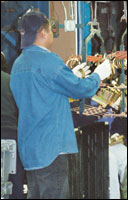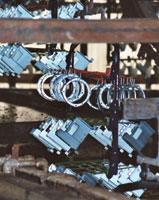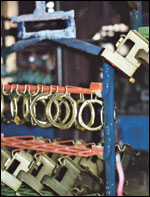United
Metal Finishers is a leader in the plating field. It is showing
the way by meeting new specifications and developing strong partnerships…
Singer/songwriter Neil Young said, “Rust never sleeps,” and it would seem neither does the mind and enthusiasm of Al Kononiuk, plant manager for United Metal Finishers (UMF). The zinc chromate plating company was recently awarded the TS 16949 certification. Always thinking about the future, Mr. Kononiuk decided that although UMF is ISO 9001-2000 certified, this was not enough for his company. He decided that UMF needed to meet the new automotive standard of TS 16949 in order to be ready for the future, which is now. UMF retained Lee Waller of Genisis Technology, who worked with Bob Davila and his team to bring the ISO project to a successful completion. This new standard, ISO TS 16949-Second Edition, was issued in March 2002 as an automotive sector-specific QMS set of requirements that uses ISO 9000:2000 (verbatim) as its base. It has replaced the ISO/TS 16949 standard based on ISO 9001, and it is intended to be an alternative to QS 9000 and other national automotive OEM supplier requirements. The International Automotive Quality Management System Standard was developed by the automotive manufacturers and the national trade associations of five countries: AIAG/US; VDA/Germany; FIEV/France; ANFIA/Italy; and SMMT/UK. The goal was to develop and publish one uniformly accepted automotive quality management system standard that would be recognized internationally. “We are a hometown plater that is going global,” stated Mr. Kononiuk. Since the company has been certified under this new specification, it has seen business that was going to Mexico and other countries come to UMF, because these other shops cannot meet the new specification. “We used to do business in our area, and, maybe some in Indiana, Michigan and Ohio. Now we can do business all over the United States and the world. Our goal, however, was not just to meet the standard, but be the benchmark for the plating industry.
“At United, we recognize our obligation to customers requiring high-quality work. Quality is a priority of every one of our employees, and we are constantly involved in making our controls and systems more reliable.” UMF is currently installing a control panel that will regulate all bath chemistries. The entire company worked to attain this certification. Most of the associates at UMF have 30 years tenure; however, even the newest employee approached this project with the enthusiasm of a true veteran. “We all started here together,” noted Mr. Kononiuk. “We watched our kids go through school, grow up, have kids of their own. Even other platers who have visited the shop remark about the family aura. It can be a serious business and still have a human factor.” One area where UMF decided to eliminate the human factor was in the plating line chemistry. Mr. Kononiuk presented his chemical supplier with a challenge. Since he believed cyanide zinc plating was a better process than non-cyanide zinc plating, he wanted Accu-Labs to partner with UMF to develop a zinc plating chemistry that was temperature tolerant with better throwing power. Cyanide zinc is not as stressed as other types of competing chemistries, so thicker deposits are possible. Also, the company, which had at one time turned away plating jobs, was taking on more work. These new jobs, including airbag components and other automotive pieces, had parts that featured more recesses and bends than previous parts UMF had plated on its dipsy doodle line. This type of line moves parts in a wave pattern through the baths, dipping them in and lifting them out and then back into the next bath.
“We engineered a low-strength cyanide zinc bath that allowed for a wider temperature range, yet still produced consistent finishes,” stated Peter Tremmel of Accu Labs. A special brightener was also developed for this line. Mr. Kononiuk named it himself, Shazam 100. “We have also worked with UMF on the chromate baths,” continued Mr. Tremmel. A typical trivalent blue chromate bath will provide up to 12 hours of salt spray protection. The one UMF installed provides a finish that withstands up to 48 hours. All parts are treated with the blue chromate prior to yellow or black, so this increases the parts’ corrosion resistance. This will also allow UMF to move away from hexavalent chromium. Chromates are available in clear (blue), yellow or black. By immersing zinc-plated work in the chromic acid solution, the surface of the zinc is converted to zinc chromate. This provides most of the corrosion resistance of the finish. Chromating does not add dimension to the deposit; therefore, dimensional tolerances on pieces such as screws and tight-fitting components are not an issue. The dichromate or yellow chromate is still a hexavalent bath. It provides a yellow iridescent finish that gives about three times as much corrosion protection as clear chromate without costing much more. Black chromate creates a slightly iridescent black finish by incorporating silver into the conversion process. The corrosion resistance offered is midway between a clear and a dichromate finish. The lightfastness of the true black chromate is frequently preferred over black dyes or other methods used to blacken zinc. The dipsy doodle continuous rack process at UMF is capable of finishing 9,000-18,000 pieces per hour and 500,000 parts per day, depending on the size and shape of the parts and zinc thickness specified. “That plating machine is a sleeper,” commented John Casperson, plating consultant. “You don’t realize how many parts come off of it. You can plate 300-350 racks of parts per hour.”
The plating system can produce thicknesses up to 0.0005 inch, depending on the size and shape of the part. The plating line sequence is shown in Figure 1. UMF is also completing a feasibility study about adding a zinc chromate hoist line. Mr. Kononiuk, always looking ahead, saw the need for tanks that could handle larger parts. The line running now limits part size to 29 inches. The new line will be able to handle parts up to six-feet long. The chemistry on the new line will be the same as what is used in the dipsy doodle line. “We may tweak it a little to improve the current density,” noted Mr. Tremmel, “but overall there isn’t much change in it.” “We are working as partners,” Mr. Kononiuk interjected. “I feel that is the key to the future of this industry, partnering.” UMF partners with its customers and its suppliers, such as Chicago Rawhide, Olsen International and Sureway Manufacturing. Mr. Kononiuk participates with his customers in developing quality standards by serving on several committees. “I think that is the highest honor a vendor can have, when a customer calls him and asks his help. Usually, the customer drives you, but we are helping drive them to higher standards. There is a dialog all around.” Partnering also includes UMF’s employees. They understand the company’s goals and are conscientious about meeting them. “The key to the future is the people we partner with,” noted Mr. Kononiuk. “That includes our suppliers, customers and associates here at UMF.” Serving
the Finishing Industries. Since 1936. |



